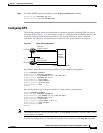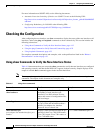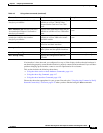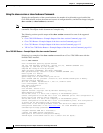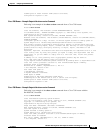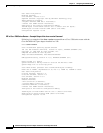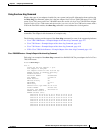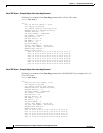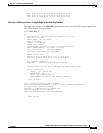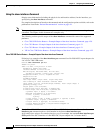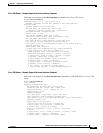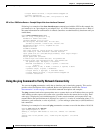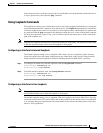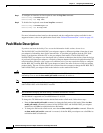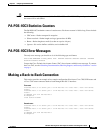
4-23
PA-POS-1OC3 Single-Port Port Adapter Installation and Configuration Guide
OL-6514-04
Chapter 4 Configuring the PA-POS-1OC3
Checking the Configuration
If the connection fails, verify that you have the correct IP address for the destination and that the device
is active (powered on), and repeat the ping command.
Using loopback Commands
The loopback test allows you to troubleshoot, detect, and isolate equipment malfunctions by testing the
connection between the OC-3 interface and a remote device. The loopback command places an interface
in internal loopback (also called local loopback) or line loopback mode, which enables test packets that
are generated from the ping command to loop through a remote device or a cable. If the packets complete
the loop, the connection is good. If not, you can isolate a fault to the remote device or the cable in the
path of the loopback test.
Note Engaging line loopback automatically switches the interface to loop timing. The interface switches back
to the user-specified timing source once the loopback is disengaged.
Configuring an Interface for Internal Loopback
The default loopback setting is for no loopback. With internal (or local) loopback, packets from the
router are looped back in the framer. Outgoing data gets looped back to the receiver without actually
being transmitted. Internal loopback is useful for checking that the PA-POS-1OC3 is working.
Step 1 To configure an interface for internal loopback, enter the loop internal command:
Router(config)# interface pos 3/0
Router(config-if)# loop internal
Step 2 To disable internal loopback, enter the no loop internal command.
Router(config)# interface pos 3/0
Router(config-if)# no loop internal
Configuring an Interface for Line Loopback
Note Engaging line loopback automatically switches the interface to loop timing. It switches back to the
user-specified timing source when the loopback is disengaged.
The default loopback setting is for no loopback. With line loopback, the receive (RX) fiber is logically
connected to the transmit (TX) optical fiber cable so that packets from the remote router are looped back
to it. Incoming data gets looped around and retransmitted to the remote end omitting the received part,
which is of no significance.



